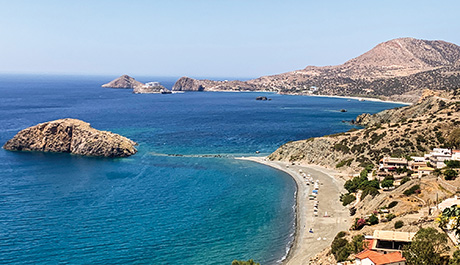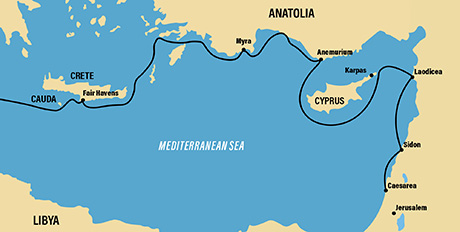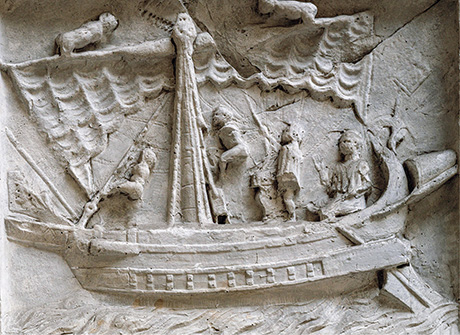“Under the Lee” with Paul

The sea was calm as our ferry departed from Hora Sfakion, a port on the southwestern coast of Crete. On this hot day in July, I was retracing part of Paul’s ill-fated voyage to Rome, as described in Acts 27–28. The hazy outline of the island of Gavdos (biblical Cauda), the southernmost landform in Europe, appeared 30 miles ahead. Paul’s ship ran “under the lee” of Cauda’s southeastern coast (Acts 27:16). Today, a small chapel near Sarakiniko Bay commemorates the apostle’s visit.
Most Bible readers are landlubbers, so when Luke, the author of the Book of Acts, introduces more than 40 nautical terms in chapters 27–28, his description can become a bit confusing. Some of these terms, including the words hypopleō and hypotrechō, both translated as “under the lee,” appear only here in the New Testament. A “lee” refers to a shelter or a side sheltered from the wind, but what exactly does “under the lee” mean in this context? A survey of the story’s geography provides an answer.
Paul’s voyage, wherein he is taken as a prisoner to stand trial in Rome, had encountered bad weather from the start. After leaving Sidon, Paul’s first ship—a coasting vessel—had continued up the eastern Mediterranean coast. Such merchant ships sailed within sight of land and stopped at a port each night for trading, food, and shelter. As it turned north-westward to sail around Cape Kleides (Karpas) on northeastern Cyprus, the small ship encountered contrary winds that forced it to sail under the lee of Cyprus (27:3–4).
Maps in Bible atlases typically portray the rerouted ship sailing north of Cyprus, but it actually would have sailed south of it. The northern path was the normal route of coasting vessels. Only Alexandrian grain ships sailed below Cyprus, which was the lee side of the island. Paul’s ship was forced to make the long detour along Cyprus’s southern coast before it could sail northward across the open sea to the Cilician port of Anemurium, the southernmost point of Anatolia. From there, the coasting vessel plied westward along the coast of Pamphylia and Lycia until it reached Andriake, the port of Myra, where Paul changed to an Alexandrian grain ship (Acts 27:5–6).
After some difficult sailing, Paul’s ship found refuge under the lee of southeastern Crete at the harbor of Fair Havens (Acts 27:7–8). Because they were sailing so late in the year, Paul warned that loss of life and cargo was inevitable if they persisted with the voyage. However, his advice was ignored on the grounds that Fair Havens was too small a port in which to winter. So they sailed toward the more suitable harbor at Phoenix (Loutro) on Crete’s southwestern coast. But as they emerged from the lee of Crete at Cape Lithinon (Lithino), a typhonic wind called a eurakylōn drove the ship southward toward Cauda.
By sailing “under the lee” of Cauda, around its southeastern tip, they were sheltered for a time from the wind and waves and the crew was able to secure the ship’s dinghy with difficulty. Modern English Bible versions (e.g., NIV and NLT) that translate skaphē as “lifeboat” are anachronistic because ancient ships never had lifeboats, a modern invention.
On my own voyage to Cauda, I gazed at Cape Tripiti, Europe’s southernmost point, which faces south toward the Libyan Sea. Here lay greater Syrtis (Gulf of Sirte), an area of treacherous sandbanks south of Cauda and off the African coast of Cyrene (Libya). The Greek geographer Strabo mentions that its shallows were a trouble spot for ships, and that if one ran aground, it was rare that the boat could be saved (Geography 17.3.20).
Returning to Acts 27, the captain ordered modifications to the ship to avoid being driven toward Syrtis (27:17). First, it was braced with cables by rigging them laterally around the hull. This prevented the joints of the planks from splitting and kept the seams tight so that they would not open because of the hull’s twisting and flexing. They then lowered the gear. In Greek nautical contexts, the gear most likely means the yard, “mainsail” lashed to it, and fair-weather topsail—not anchors. Lowering these was critical to prevent the mast from cracking and to deploy a storm sail closer to the deck for maintaining steerageway.
As they emerged from the lee of Cauda, the rough seas forced the crew to jettison the cargo and the ship’s tackle (Acts 27:18–19). But these actions only prolonged the inevitable—the shipwreck and eventual coming ashore on Malta.
Throughout Acts 27, we see that only by getting under the sheltered lee side of an island and avoiding the northwesterly winds could the ships transporting Paul make any progress. While the coasting vessel that Paul boarded at Caesarea eventually arrived in Myra, the Alexandrian grain ship, after passing Cauda, no longer had the lee of an island for shelter. The voyage became doomed, but Paul miraculously escaped with his 275 shipmates and lived to see another day.1
As the ferry returned to Crete, rugged mountains rose along the southern coast as far as my eyes could see. It was easy to imagine a gale sweeping down their slopes and driving Paul’s ship southward under Cauda’s lee. The swells of the sea were moderate. Fortunately, this short voyage was not to have a shipwreck, one of Paul’s experiences I hopefully will never have to endure.
MLA Citation
Endnotes
1. For a discussion of this voyage and its challenges, see Mark Wilson, “Luke for Landlubbers: The Translation and Interpretation of ὑποπλέω in Acts 27,” Acta Theologica 42.2 (2022), pp. 343–366.



